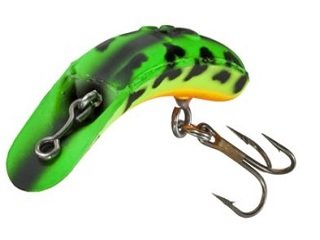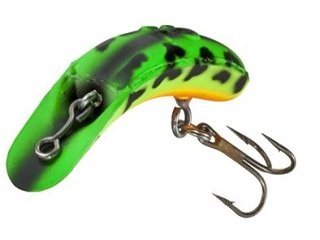 Have you ever looked at a lure and wondered how such a seemingly simple design can be so effective on the water? I’m sure many anglers have. However, outward simplicity often contains amazing efficiency and intentional craftsmanship, especially when it comes to fishing lures. Today, we’ll explore the anatomy of such a lure as we take a closer look at the popular flatfish.
Have you ever looked at a lure and wondered how such a seemingly simple design can be so effective on the water? I’m sure many anglers have. However, outward simplicity often contains amazing efficiency and intentional craftsmanship, especially when it comes to fishing lures. Today, we’ll explore the anatomy of such a lure as we take a closer look at the popular flatfish.
The shape of the flatfish lure is difficult to describe. Its molded balsa body begins with a rounded, blunt end and then curves into a flattened bill where it connects to the fishing line. Beneath the body hangs a single treble hook, which does a great job of hooking fish while reducing the risk of snags that are popular where more hooks are present. This design creates balance and buoyancy that enhances the flatfish’s unique action.
The flatfish can be used in a variety of situations to catch many different types of fish. The lure’s true effectiveness shines when it’s fished slowly, though, which allows it to wobble with an erratic side-to-side action that fish can’t resist. For this reason, many find trolling to be a great way to work the flatfish. This need for a slow retrieve doesn’t earn it a top spot on bass anglers’ lists, though.
Available in six sizes and over a hundred colors, there is a flatfish for every situation you may encounter on the water. The small sizes can be used on small streams and rivers, as well as lakes, where you can slow troll for trout, bass, perch, or crappie. These smaller sizes can also be used for fly fishing. The larger flatfish sizes are recommended for spinning tackle and can be used in lakes and streams for trout, bass and walleye. The diving depth will alter slightly between sizes, but retrieval speed also factors into that, as well, which is a good thing to keep in mind.
There are many anglers who have never heard of a flatfish, let alone fished with one. If you count yourself among them, you’d be doing yourself a favor if you grabbed a few this season. On a slow retrieve, their intense wobbling action drives fish crazy and will have your livewell filled in no time.








